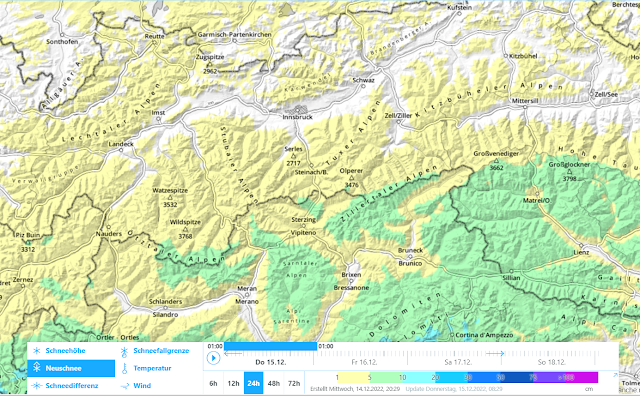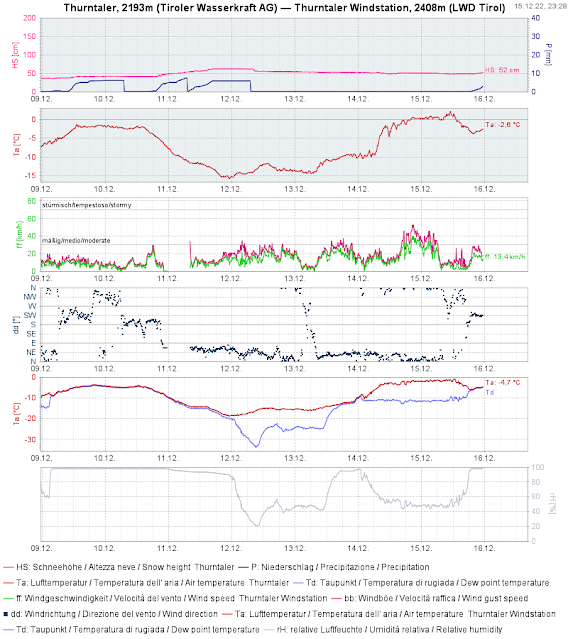Peristent weak layer, still not enough snow
Starting at about 2000 m there are weak layers of faceted crystals inside the old snowpack. These often border against a crust. Frequently, a “crust sandwich” is observed: a weak layer between two crusts. For a slab avalanche, a hardened, deeper layer is required atop the weak layer, the so-called “slab.” Since there is still so little snow in many regions of Tirol, the slab is not pronounced. Due to the cold temperatures from 10-13 December, this snow has now changed, forfeited some of its firmness and thereby become less prone to triggering. That’s the reason behind the current decrease in avalanche danger from Level 3 (considerable) to Level 2 (moderate) above approximately 2000 m.
Nevertheless, in wind-loaded gullies and bowls as well as ridgeline and pass areas above 2000 m, caution is still imperative. Wherever there is more snow, slabs can be triggered by winter sports enthusiasts. This is increasingly the case on shady slopes above 2000 m. At higher altitudes it also applies to sunny slopes.
.jpg) |
| Typical of the current snowpack layering: a sequence of crusts and softer layers (photo: 14.02.2022) |
 |
| A crust sandwich on a 33° steep south-facing slope at 2250m in the western Verwall Massif. For slab avalanches, the slab is still lacking. |
.jpg) |
| The slab of the previous photo, up close. Ridgeline fracture. Small avalanche. (photo: 15.12.2022) |
 |
| The snow profile for the above photo: a faceted layer beneath a thin crust as weak layer: 2385m, NE, 35°. Profile from 15.12.2022 |
.jpg) |
| Ridgeline slab on a shady slope in the eastern Deferegger Alps (photo: 14.12.2022) |
Not much snow
.jpg) |
| Little snow in the Tux Alps. Thus, heightened danger of injuries during a descent (photo: 15.12.2022) |
.jpg) |
| Insufficient snow in the western Verwall Massif (photo: 15.12.2022) |
.jpg) |
| A bit more wintery in northern East Tirol, but frequently one breaks through to the ground. (photo: 12.12.2022) |
We recommend...
It’s best on snowy grass-covered slopes, where there are no massively drifted areas or very steep zones. What matters more: the danger of injuries from “sharks” (rocks hidden beneath the surface) is far less.
.jpg) |
| Relatively more relaxed descents in spite of insufficient snow: photo from 11 December in Ausserfern. The snow situation in the Kitzbühel Alps is better by comparison. |
Instead of skiing tours or treks in outlying terrain, this slot in time might be used for advanced education, for example, training in beaming devices, first-aid, avalanche courses including equipment checks.
.jpg) |
| During an Avalanche Commission course, a variety of avalanche emergency situations were trained for with helicopter support, as visible above. (photo: 15.12.2022) |
What’s the outlook?
According to ZAMG Weather Service we are about to get two minor bouts of precipitation, one from the southwest in a warm front, one from the northwest in a cold front. Anticipated amounts hover around 10 cm. On the weekend, conditions will improve: from Saturday to Sunday, clear nighttime skies are anticipated.
 |
| Precipitation on 15.12 starting in late afternoon |
 |
| Snow forecast for 16.12.2022 |
Initially, not much change is expected in the avalanche situation. The treacherous persistent weak layer will stay with us. In addition, freshly generated snowdrifts at high altitudes need sharp attentiveness.
_bearbeitet.jpg)
